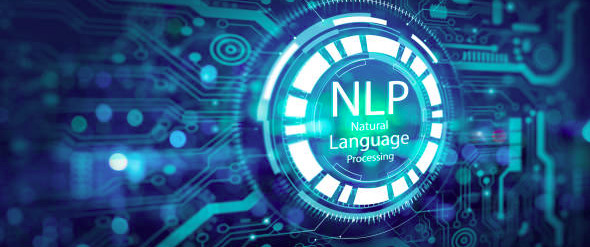Regardless of how you look at it, AI today can listen, understand, speak, respond, and write in human language. A semi of artificial intelligence known as Natural Language Processing (NLP) is also available in sci-fi scenarios.
Natural Language Processing, more often known as NLP, is remarkable for extracting the most significant amount of meaning from human speech. An artificial intelligence (AI) system is like a human brain in that it understands the language, analyses context, and processes it to return a specific response or follow an order.
First, let’s take a closer look at how NLP works. Even though the innovation is still in its infancy, many enterprises already utilise it, allowing them to improve their workflow procedures and productivity. Specifically, in this blog, we’ll focus on the different uses of NLP for organisations of all kinds.
What is Natural Language Processing?
Artificial intelligence (AI) has a branch called “Natural Language Processing” (NLP), which attempts to give robots the capacity to interpret and deduce the meaning of human language.
Technology that helps computers comprehend natural human language is known as Natural Language Processing (NLP).
Repetitive yet mentally taxing jobs like emotion detection, machine translation, and spell-checking fall within this category. Speech or text may be precisely analysed by computers using NLP.
Why is NLP so complicated?
While the advantages of NLP apprentices, specific issues need to be addressed:
- In addition to the ambiguity and complexity of human language, there are over 6500 languages now spoken throughout the world, each with its unique set of linguistic laws.
- NLP recognises unstructured language and transforms it into information that machines can utilise through Machine Learning (ML) techniques. Data pre-processing is a part of NLP. As part of the initial step in processing language, computers must be able to interpret it.
- Natural Language Processing (NLP) is a branch of computer science that translates human language into a form that computers can understand. People don’t use essential words in our languages. Context is everything when it comes to an understanding the meaning of a word.
- To decipher sarcasm or irony, you need to know how to read the tone of the speaker’s voice.
How does NLP work?
Several fundamental ideas must be learned before venturing into a career in Natural Language Processing (NLP). NLP does not have a single, set approach. Multiple strategies must be combined to increase the amount of information that may be manipulated via language.
It should come as no surprise that NLP uses methods we are familiar with from linguistics. Language processing often involves the following four steps:
- Morphology is the study of how words are generated and how they relate to each other in terms of morphological structure.
- The way these words are arranged in a phrase is called syntax.
- Semantics is the study of how grammar and lexical meaning disclose a word’s meaning.
- Pragmatics is the study of how words are used in conversation.
Each of these stages adds a new layer of context to words. Investigate some of NLP’s most widely utilised strategies.
NLP Applications and Benefits
Just a handful of the top-level benefits of NLP that will help your company become more competitive are listed here.
- Unstructured text data, such as comments on social media, call logs, online reviews, and news items, may be understood and analysed by machines using Natural Language Processing (NLP).
- Real-time automation of processes Due to the use of natural language processing technologies, robots may learn how to sort and collect this information without the need for human intervention in a short period.
- Make use of NLP technologies that are specific to your field. Even sarcasm and another often misunderstood language may be accommodated by natural language processing algorithms, which can be customised to your demands and criteria.
How is NLP used in business?
Let’s begin with the commercialisation of our subject matter. In the business world, Natural Language Processing may be used. The business has several fascinating and essential use cases and difficulties that may be addressed using Natural Language Processing, as is very clear here.
Sentiment Analysis
It is commonly utilised in digital marketing and online monitoring to gain insights into customers’ thoughts about specific items or services. Customers’ opinions on a product may help any firm better understand the possibilities for development and how to attain a product’s long-term viability. Machine learning and deep learning, and big data analytics must be used in conjunction with natural language processing to do the back-end computation.
Email Filters
Emails have been formally accepted as a means of communication, but this media is susceptible to content spamming. Email domain providers are investigating a variety of procedures to make them 100% secure. Email filtering is an everyday use of Natural Language Processing. Spam detection is a pre-processing tool for sentiment analysis.
Voice Recognition
To better handle Artificial Intelligence, the first step is to reduce the communication gap between humans and computers. Natural Language Understanding, a sub-process of Natural Language Processing, is the only way to accomplish this goal. Firms may use these methods to design innovative audio services and interactions for any product or service powered by Natural Language Processing.
Information Extraction
The majority of the data received at each receiving end is unstructured. Prescriptive modelling and prescriptive analytics are increasingly accurate due to complex statistical algorithms. They need an ever-increasing amount of data to detect patterns. Machine Learning and Deep Learning cannot be without Machine Translation.
What NLP can and cannot do for your firm?
Thanks to Natural Language Processing (NLP), we can do automation differently. NLP may be used in a variety of ways, such as:
- With NLP, data from surveys, reviews, and social media may be used better to understand your product than ever before through sentiment analysis. Artificial Intelligence (AI) and chatbots may address simple customer service questions.
- Researchers at MIT have used NLP to categorise material as politically biased and developed the Fake News Filter.
- Social Media Analysis: NLP can assist you in analysing the sentiment and subject categorisation tailored to your unique criteria for brand health and community creation.
- Spam detection, the definition of what urgent emails mean to your company, and routing of emails to specific departments are all features of email filters.
- Survey Analytics: Automated analysis of employee or customer feedback questionnaires.
NLP Tools
There are many internet resources to help you get started with NLP.
- IBM’s Watson supercomputer
- Lexalytics
- Google’s Cloud NLP
- Clarabridge
- Comprehend Amazon
There are several no-code options available if you don’t want to deal with writing your NLP models. You simply need to input your data, give the machine some labels and parameters to learn from, and the platform will handle the rest for you with these kinds of tools.
Data entry and labelling may be done on-the-fly with no-code solutions by some of the best Artificial Intelligence development companies.
For example, in spam detection, you simply need to tell the computer what you call spam and what you consider non-spam, and the computer will build its associations based on that information.
Use the widget below to test our sentiment classification widget (favourable or unfavourable sentiment will be identified)!
NLP Limitations
The price of building your models should be considered if you’re planning on doing so.
NLP models require a long time to train. Getting solid findings from some models may take many weeks. You should thus consider hard before choosing an NLP solution when working with tight timelines, especially when you construct it in-house.
Artificial neural networks still lag far behind the human brain’s efficiency in NLP technology, requiring tremendous computer power. More crucially, the model’s performance is limited by the data quality used to train it, as all machine learning techniques are actual. With NLP, it is difficult to guarantee 100% accuracy unless a defined procedure is in place.
In light of NLP’s data-driven findings, it is critical to ensure that many resources are accessible to train models. In languages with less than a million speakers, this can be challenging.
Final Words on Natural Language Processing
Automated operations, including translation, summarisation, categorization and extraction, change how we interact with dialect data through natural language processing (NLP).
Computers that can understand human language were formerly thought to be an impossibility. On the other hand, NLP has risen to prominence in AI in a brief period, thanks to advances in linguistics, computer programming, and machine learning.
Author Byline:
Rajalekshmy KR, SEO Content Specialist working in NeoITO– a reliable web development company in USA. She always seeks feedback from tech founders, product owners, and business strategists to write about subjects valuable to her readers.





















